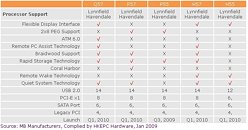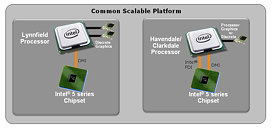Sunday, January 18th 2009

Intel 5-Series Chipset Lineup Detailed
Now faced with delays, Intel's upcoming Ibex-Peak platform, a next-generation mainstream implementation of the Nehalem architecture, is an interesting mix of technologies, where Intel seeks to minimise the platform and energy footprints while delivering value and performance through a clever bit of rearrangement of system components. HKEPC has learned that Intel's 5-Series mainstream chipsets consists of five models: P57, Q57, H57, P55, and H55. The P57 and P55 are built for the consumer PC with discrete graphics. The H57 and H55 chipsets are built for processors with integrated graphics, with support for the Intel FDI. The Q57 is built for the business / enterprise-client PC, it supports a host of exclusive Intel technologies that make the machine easier to manage.With Intel's upcoming Lynnfield quad-core and Havendale dual-core processors go a step beyond merely housing the memory controllers. They now also integrate PCI-Express root complexes, and some models even feature integrated graphics controllers on-die. This completely eliminates the requirement of a northbridge, leaving a southbridge to handle storage and peripherals. What this design does is that it eliminates a system bus between the CPU and the motherboard, with the components housed in the CPU having an internal QuickPath Interconnect linking all components, which aims to bring down latencies. The only connections the processor ends up having with the motherboard would be the PCI-Express lanes, a DMI connection to the southbridge, connections for the dual-channel DDR3 memory, and for processors with IGPs, a separate connection called Intel Flexible Display interface that routes the IGP to its I/O via the southbridge. The processor uses the newer LGA-1160 socket.The PCI-Express root complex the processors come with can support up to two graphics cards with 8 PCI-Express 2.0 lanes each, or a single graphics card with full-bandwidth 16 lanes. The ATI CrossFireX multi-GPU technology is supported, while SLI support isn't known as yet. While 8 PCI-E 2.0 lanes to drive today's powerful GPUs sounds like a cause for concern, later down the line, one can expect motherboard vendors work around this bottleneck using PCI-E multiplex chips such as the NVIDIA BR-03, that provide full x16 connections to each graphics card, and attempt to boost performance using data-broadcast functions. All models of the 5-series PCH chipsets support six SATA II connections, and as many as 14 USB 2.0 ports. The 5-series chipset launch schedule spans from Q3 2009 to Q1 2010, though with news emerging of delays in the launch schedule, these could be pushed further away, maybe into 2010 altogether.
Source:
HKEPC



14 Comments on Intel 5-Series Chipset Lineup Detailed
THIS IS A SYMPTOM of mismanagement at Intel... too many branches in their organisation resulting in too many similar and competing product offerings. Now mix in Atom, Larrabee and Server chipsets/CPUs and you have a complete mess.
Let's just wait to see how OEMs will enjoy stockpiling of chipsets.
Let's just wait to see how consumers get tired of out-of-stock mainboards and CPUs.
Let's just wait to see how many crappy discount computers are built on the "overstocks" of unwanted parts.
:shadedshu
and is it me or is the nomenclature of the sets now totally SNAFU? P57?
That doesn't make good business sense.
They're coming out with this new chipset for their new 32nm processor, Westmere. Which means that if you want to use their new 32nm processor then you need a 5 series motherboard chipset because Westmere is going to have the GFX and memory controller inside the processor.
Long story short, i dont think they are set on this chipset, they might come out with or change it so it has more then one x16 channel